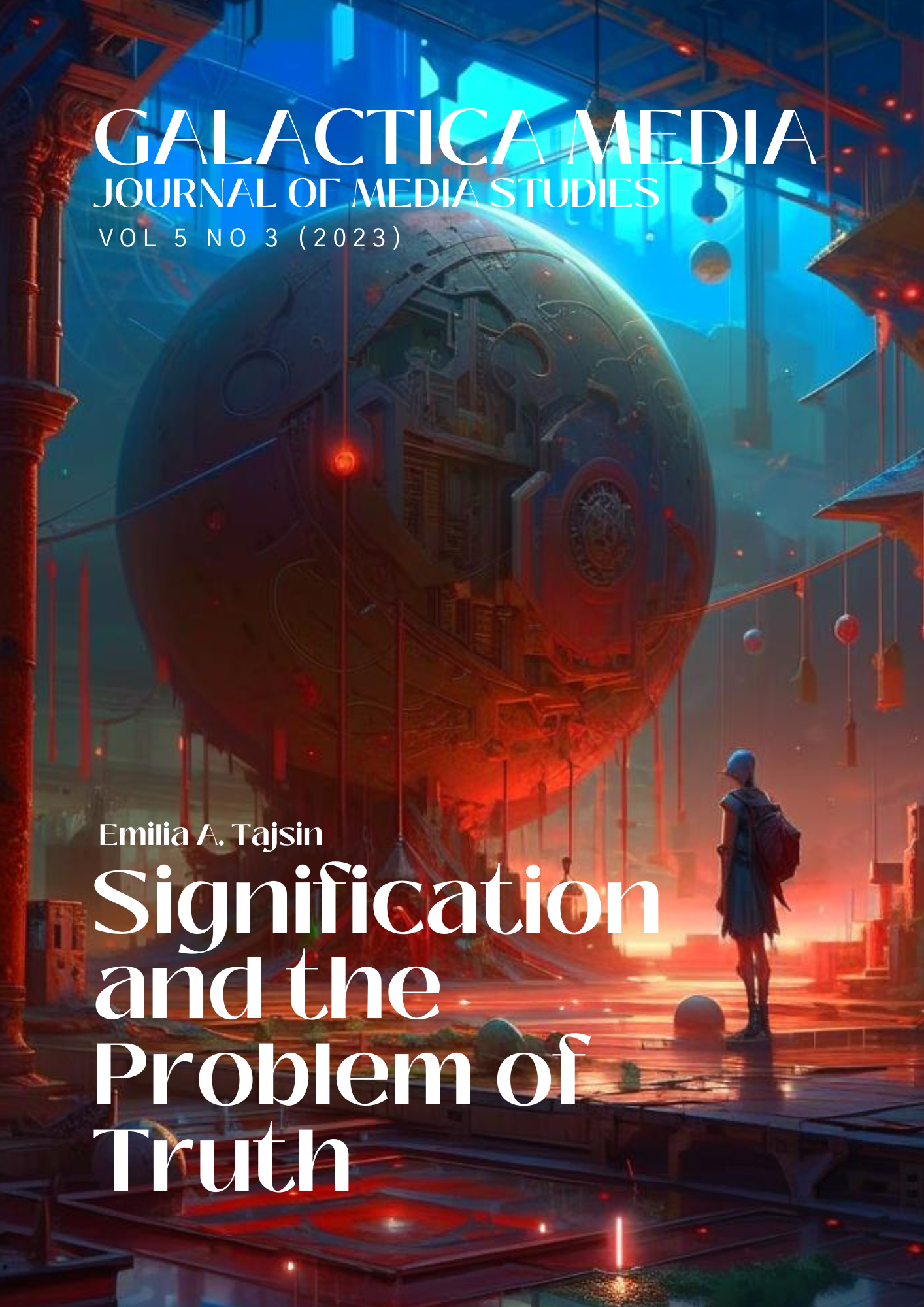Abstract
The great hopes of scientists in various fields, from computer science and mathematics to literature and art criticism, from analytical philosophy to post-structuralism, in the last third of the 20th and first quarter of the 21st centuries are assigned to semiotics, or the general theory of signs, which studies signification and its laws. Signification, or designation (denotation, signalizing, symbolization) is the widest-common procedure in scientific creativity and culture in general.
The scope of the semiotic approach and the abstractness of the categories of semiotics are such that they allow for speaking at least of the theoretical-cognitive, if not ontological, universality of its approaches and the general methodological validity of its tools. One is capable of thinking only on the basis of the semiotic mediation of reality; moreover, the essence of consciousness itself as a whole is reflective, and representative. The recognition of the great informative capacity and value of the basic semiotic concepts, as well as the extreme breadth of the subject of semiotics due to the actual or potential symbolic nature of human science and culture, the instrumental nature of signs and symbols which science, ethics, religion, and art are full of, allows us to hope that semiotics will play, in the near future, the role of a universal manifestor and communicator.
References
Aristotle. (1976). Categories. On Interpretation. In Collected Works in 4 Volumes: Vol. II. Mysl’. (In Russian).
Boethius. (1990). Consolation of Philosophy and Other Treatises. Moscow. (In Russian).
Czarnocka, M. (2017). A Path to a Conception of Symbolic Truth. Peter Lang Verlag. https://doi.org/10.3726/978-3-653-05546-7
De Mauro, T. (2000). Introduction to Semantics (B. P. Narumov, Trans.). Dik. (In Russian).
Dilthey, V. (1924). Descriptive Psychology. Moscow. (In Russian).
Eco, U. (1976). A Theory of Semiotics. Bloomington. https://doi.org/10.1007/978-1-349-15849-2
Frankfort, H., Groynewegen-Frankfort, G. A., Wilson, J. A., & Jacobsen, T. (1984). In anticipation of philosophy. Nauka. (In Russian).
Frege, G. (1993). Der Gedanke. Eine logische Untersuchung [The Thought. A logical investigation]. Logische Untersuchungen. (In German).
Harman, G. (2015). The Quadruple Object: Metaphysics of Things After Heidegger. Gill Press. (In Russian).
Heidegger, M. (1989). On the Essence of Truth. Philosophical Sciences, 4, 91–104. (In Russian).
Heidegger, M. (1994). On the Purpose of Thought // Philosophy of Consciousness in the 20th Century: Problems and Solutions (A. N. Portnov, Trans.). Ivanovo. (In Russian).
Horwich, P. (2013). Truth. In F. Jackson & M. Smith (Eds.), The Oxford Handbook of Contemporary Philosophy. Part IV. Philosophy of Language. Oxford University Press.
Ivanov, V. V. (1984). BEFORE – TIME – AFTER? (instead of a preface). In G. Frankfurt, G. A. Groeneveld-Frankfort, D. A. Wilson, & T. Jakobsen, On the Eve of Philosophy. Nauka. (In Russian).
Kasavin, I. T. (1990). On the Descriptive Understanding of Truth. Philosophical Sciences, 8, 64‑73. (In Russian).
Kasavin, I. T. (2000). Traditions and Interpretations: Fragments of Historical Epistemology. Publishing House RHGI. (In Russian).
Koshelev, A. D. (Ed.). (1994). Yu. M. Lotman and the Tartu-Moscow Semiotic School. Gnosis. (In Russian).
Lenin, V. I. (1967). Materialism and Empirio-Criticism. Chapter II. The Theory of Knowledge of Empirio-Criticism and Dialectical Materialism. In Complete Collected Works (Vol. 18). Politizdat. (In Russian).
Locke, J. (1894). An Essay Concerning Human Understanding. George Routledge and sons LTD. (In Russian).
Lotman, Yu. M. (Ed.). (1965). Works on Sign Systems. Tartu. (In Russian).
Meillassoux, Q. (2015). After Finitude: An Essay on the Necessity of Contingency. Cabinet Scientist. (In Russian).
Mikeshina, L. A. (1990). Contemporary problematization of the eternal theme. Philosophical Sciences, 10, 77–78. (In Russian).
Mikeshina, L. A. (2002). Philosophy of Cognition: Polemical Chapters. Progress-Tradition. (In Russian).
Mikeshina, L. A. (2005). Philosophy of Science: Contemporary Epistemology. Scientific Knowledge in the Dynamics of Culture. Methodology of Scientific Research: Textbook. Progress-Tradition. (In Russian).
Narsky, I. S. (1985). John Locke and His Theoretical System. In J. Locke, Works in 3 Volumes: Vol. I. Mysl’. (In Russian).
Narsky, I. S. (1989). Introductory Article to M. Heidegger’s Work ‘On the Essence of Truth’. Philosophical Sciences, 4. (In Russian).
Ockham, W. (2002). Selected Works. RAN IF Editorial URSS. (In Russian).
Philosophy, Culture, Education in the 21st Century: Collection of Articles and Theses of the All-Russian Scientific and Practical Conference. (2011). Kazan. (In Russian).
Philosophy, Logic, Language. (1987). Moscow. (In Russian).
Philosophy. Language. Cognition. Collection of Jubilee Materials. (2011). KGAEU. (In Russian).
Plato. (1994). Cratylus. In Collected Works in 4 Volumes: Vol. III. Mysl’. (In Russian).
Sciences of Language and Text in Europe of the 14th-16th Centuries. (2016). Delo RANHiGS Publishers. (In Russian).
Stepanov, Yu. S. (2001). Introduction Article. In Yu. S. Stepanov (Ed.), Semiotics. Anthology (2nd ed.). Academic Project; Delovaya Kniga. (In Russian).
Surovtsev, V. A. (2008). On the Logical-Philosophical Views of Gottlob Frege. In G. Frege, Logical-Philosophical Works. Logical Investigations. The Foundations of Arithmetic. Siberian University Press. (In Russian).
Taysina, E. A. (2013). Theory of Cognition. Introduction and Capricious Rondo. Aleteiya. (In Russian).
Taysina, E. A. (2014). Philosophical Questions of Semiotics. Aleteiya. (In Russian).
Volkov, A. G. (1966). Language as a System of Signs. Moscow. (In Russian).
Vygodsky, M. Ya. (1977). Handbook of Higher Mathematics. § 368. Nauka. (In Russian).
Zamyatin, D. N. (2004). Metageography: Images of Space and Spaces of Images. Agraf. (In Russian).

This work is licensed under a Creative Commons Attribution 4.0 International License.

